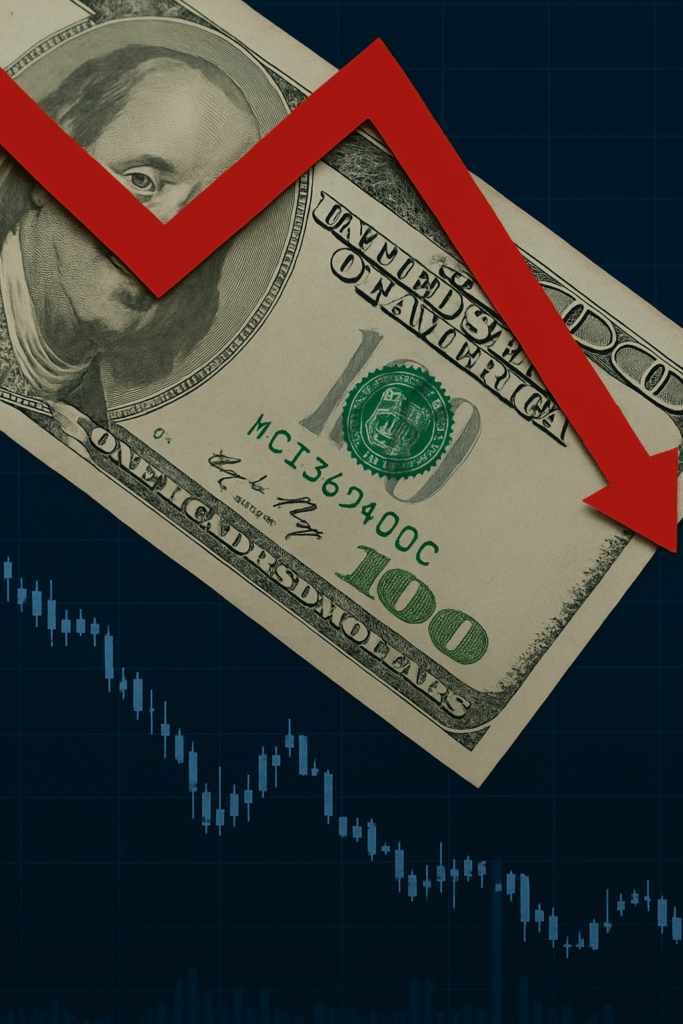The US dollar index 2025 crash is sounding alarms across global financial markets. For the first time in over two years, the DXY (U.S. Dollar Index) has plunged below 99, marking a significant psychological and technical breakdown. Down nearly 10% since January, this sharp slide in the dollar is far more than a routine dip it’s a potential sign of deeper economic challenges and shifting global power dynamics.
This dramatic fall in the dollar’s value is not just a headline it’s a direct hit to the heart of global finance, impacting everything from consumer prices in the U.S. to trade balances abroad.
Why Is the US Dollar Falling in 2025?

Several high-impact economic and geopolitical forces have converged this year to drive down the dollar:
1. Fed Rate Cuts 2025
The Federal Reserve has already implemented one rate cut and signaled at least another by year-end. While intended to support a slowing economy, lower interest rates reduce the attractiveness of the dollar to foreign investors, leading to weaker demand and lower value.
2. Rising National Debt and Fiscal Concerns
The U.S. national debt has now surged past $35 trillion, raising concerns among economists and investors about long-term fiscal sustainability. As the government continues borrowing heavily to support spending, market confidence in the dollar’s long-term strength is eroding.
3. BRICS De-Dollarization 2025
Emerging economies are stepping away from the dollar. The BRICS alliance Brazil, Russia, India, China, and South Africa is ramping up efforts to build alternative trade and payment systems that bypass the greenback. This BRICS de-dollarization 2025 movement is reducing global reliance on the U.S. dollar, contributing to its recent weakness.
4. Geopolitical and Political Uncertainty
With a volatile U.S. election season underway and rising tensions abroad, markets are jittery. Investors fear sudden changes to trade policy, tax structures, and regulatory environments — all of which can influence currency strength.
The Impact of a Falling US Dollar in 2025
The impact of the weak dollar on the economy is broad and complex. While some sectors benefit, others struggle to cope with the consequences.
Who Benefits:
- U.S. Exporters: A weaker dollar makes American goods cheaper abroad, helping manufacturers and agriculture.
- Inbound Tourism: Foreign tourists get more for their money, potentially boosting the U.S. hospitality sector.
- Investors in Gold & Crypto: Historically, alternative assets like gold and Bitcoin rise when the dollar weakens. In 2025, gold has already surged past $2,350/oz, and crypto markets are seeing renewed bullish momentum.
Who Suffers:
- American Travelers: Overseas vacations become costlier as the dollar loses purchasing power.
- Retailers and Importers: Companies dependent on foreign goods are facing rising costs, which may be passed on to consumers.
- Consumers at Large: A falling US dollar in 2025 could spark imported inflation, driving up prices for items like electronics, cars, and oil.
Market Reactions to DXY Below 99
As the DXY falls below 99, financial markets are reacting with both caution and opportunity. The S&P 500 remains volatile, caught between the tailwinds of Fed stimulus and the headwinds of currency instability.
Currency analysts warn that if current trends persist, the US dollar forecast 2025 could see further deterioration, possibly dipping into the mid-90s range on the index a level not seen since 2020.
What Experts Are Saying
“This isn’t just a cyclical correction it’s potentially a structural shift,” says Karen Rollins, Chief FX Strategist at GlobalBank. “Until we see meaningful fiscal reforms and a clear political direction, the dollar will remain under pressure. Investors should prepare for a prolonged period of currency volatility.”
Other analysts echo these sentiments, pointing to the growing power of emerging markets, a more multipolar economic order, and the internal fiscal imbalances in the U.S. as key drivers of the dollar’s slide.
What’s Next for the US Dollar?
The Federal Reserve’s September meeting is now in sharp focus. A second rate cut this year could push the DXY even lower, triggering renewed concerns about the US dollar index 2025 crash deepening further.
In the meantime, economists advise businesses and consumers alike to brace for more price fluctuations, especially in energy, imports, and international travel.







